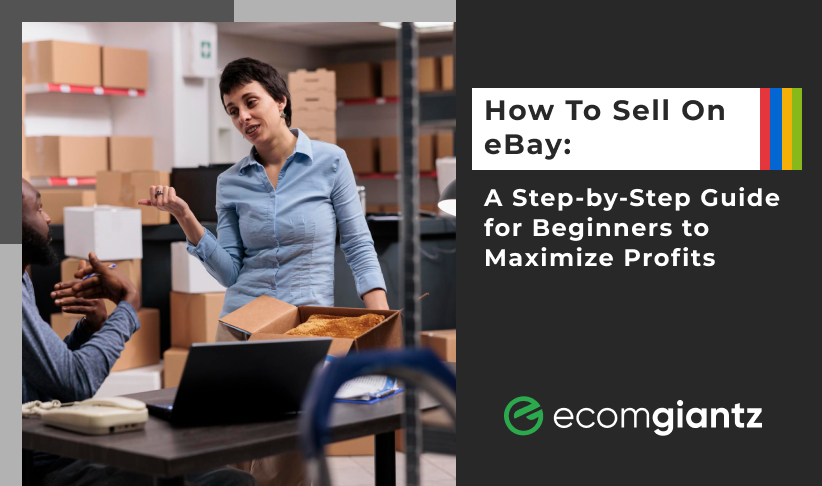In the current economy, more individuals than ever before are looking to sell gently used items online through marketplaces, ranging from vintage clothing and old phones to furniture and collectibles. Whether you're cleaning out your house or creating a side business of reselling goods, the used goods market is thriving.
Of all the sites out there, selling second-hand goods online is easiest on eBay. With a global reach, good reputation, and immense product category choice, eBay offers unmatched flexibility and profitability. Whether you've got a unique find or something more mundane, eBay introduces you to millions of active buyers globally, so it's never easier or more profitable to sell your second-hand stuff.
Why eBay is the Best Place to Sell Used Goods
For selling used goods online, no site provides the same combination of visibility, flexibility, and profitability as eBay. It's not merely an online marketplace it's a brand that is well known and respected worldwide, with more than 130 million active users globally. That equates to your used item not only reaching buyers in your immediate vicinity—it's viewed by shoppers from almost every region on the planet.
eBay also considers secondhand sellers. Whether you're selling vintage watches, used electronics, or a designer handbag, there's a niche category and customer base for it. The site offers strong tools like sold listings, price data, and shipping calculators so sellers can make intelligent decisions even if they're newbies.
And, to top it all, eBay leaves you in total control of how you sell. You can choose auction or fixed price, determine your shipping choices, and even offer returns if you wish to build buyer confidence. With its minimal startup cost, massive exposure, and proven buyer trust, eBay is the go-to site for turning used items into real profit whether you're a weekend declutterer or an entrepreneur starting a full-time resale venture.
With so many options for selling online, from Facebook Marketplace and Craigslist to Poshmark, Mercari, and Depop, choosing the right platform to sell your used goods can feel overwhelming. But eBay continues to lead the pack for one simple reason: it’s built for sellers of all sizes, in nearly every category, with a global buyer base.
Unlike platforms that focus only on clothing, local pickup, or niche items, eBay supports everything from vintage collectibles and electronics to auto parts and home goods, giving you more chances to sell and a wider audience to reach.
Platform Comparison Snapshot:
- eBay: Global reach, auction + fixed-price formats, huge buyer pool, broad category support
- Facebook Marketplace: Local selling, limited buyer protection, no shipping support
- Poshmark/Depop: Great for fashion, but limited categories and higher fees
- Craigslist: Free to use, but no payment protection and limited to local buyers
- Mercari: Good for small items and beginner sellers, but less traffic and exposure
While others may work well for specific product types or local selling, eBay offers the most versatility and long-term growth potential, especially if you’re serious about turning your used goods into a steady income stream.
Benefits of eBay for Used Goods
Selling used items on eBay isn’t just convenient; it’s strategic. Whether you're downsizing, flipping, or simply cleaning up, eBay offers a unique combination of tools and trust that helps sellers succeed.
Global Reach: With over 130 million active users worldwide, your listing can reach far beyond your neighborhood. Unlike local marketplaces, eBay opens the door to buyers across countries, increasing your chances of a quicker and more profitable sale.
Flexible Selling Formats: Choose between auction-style listings (perfect for rare or in-demand items) or fixed-price formats when you know exactly what your item is worth.
Powerful Seller Tools: eBay gives you access to tools like Terapeak for product research, bulk listing options, automated shipping label creation, and real-time analytics, all designed to help you work smarter.
Secure Transactions & Buyer Protection: eBay manages payments and offers both buyers and sellers protection against fraud, making the platform trustworthy for everyone involved.
Vast Range of Categories: From electronics and fashion to vintage collectibles and auto parts, eBay supports a wide range of secondhand categories so you're never limited by niche restrictions.
Note: eBay rewards consistency. Build your reputation through positive reviews, fast shipping, and accurate listings, and you’ll gradually unlock more visibility and perks like Top Rated Seller status.
Understanding eBay Seller Fees and Costs
Before you start listing your used items on eBay, it's important to understand the platform’s fee structure so you can price your products smartly and maximize profit. eBay’s fees are generally straightforward, but a few details can make a big difference in your margins.
1. Final Value Fee: This is the main fee you’ll pay a percentage of the total sale price (including shipping). It typically ranges between 10% to 15%, depending on the category. eBay deducts this automatically once your item sells.
2. Insertion Fee: eBay allows you to list up to 250 items per month for free (as of 2025). Beyond that, you’ll pay a small insertion fee. Usually around $0.35 per listing. You’ll also incur this fee if you list the same item in multiple categories.
3. Optional Listing Upgrades: Want to highlight your listing with bold fonts or a subtitle? These features cost extra. Most beginners skip these unless they’re selling high-value or highly competitive items.
4. Promoted Listings: If you want more visibility in search, you can opt into eBay’s advertising program. You only pay a small percentage if the item sells through the ad. Great for boosting sales of competitive products.
So, use eBay’s Fee Calculator to estimate your costs upfront.
Setting Up an eBay Seller Account
I will show you the step-by-step guideline on how to Set Up an eBay Seller Account
Step 1: Sign Up for an eBay Account
Go to eBay.com and click “Register.”
You can choose to sign up with your email, Google, Apple ID, or Facebook.
Step 2: Choose Between Personal or Business Account
- Personal account: Great for casual or part-time sellers.
- Business account: Ideal for registered businesses or high-volume sellers.
Select the one that fits your goals. You can upgrade it later if you want.
Step 3: Enter Contact and Business Info
Add your name, phone number, and address. If it’s a business account, include your company name and registration details.
Step 4: Set Up Payment Method
Link your bank account so eBay can send you payouts. eBay manages all buyer payments, so this is the essential part of account setting.
Step 5: Verify Identity
After that, eBay may ask you to verify your identity with a government-issued ID and bank verification to keep your account secure. You have to verify your identity.
Step 6: Customize Your Seller Profile
Add a profile photo or logo, write a short seller bio, and choose your username/store name if you want branding.
Step 7: Start Listing Items
Click “Sell” from your dashboard, and create your first product listing with a good title, photos, descriptions, specifications, and pricing.
Finding and Preparing Used Goods to Sell
Once the eBay seller account is ready, the next step is sourcing quality used products and preparing them for sale. Whether you’re decluttering your home or building a resale side hustle, knowing what to sell and how to present it can make all the difference.
Start with these reliable sources to build your used inventory:
- Around the house: Electronics, clothing, books, tools, and gadgets you no longer need are perfect to start.
- Garage sales & estate sales: Often overlooked, these can be gold mines for collectibles, vintage items, and electronics.
- Thrift stores & charity shops: Gently used fashion, home goods, and toys can often be resold for a healthy margin.
- Facebook Marketplace & Craigslist: You can find local deals sometimes even free items that are undervalued or poorly listed.
- Friends & family: Let people know you’re reselling. Many are happy to give away items they no longer use.
Note: Focus on items that are easy to ship, in good condition, and have a proven track record of selling on eBay. Use eBay’s "Sold Listings" filter to check demand and pricing.
How to Prepare Items for Resale
Once you’ve sourced items, it’s important to clean them, inspect them, and list them properly. A little effort up front can lead to better feedback and higher profits.
- Clean & test: Wipe down items, wash clothing, and make sure electronics work properly.
- Take high-quality photos: Use natural light, show all angles, and include close-ups of any flaws.
- Be honest in descriptions: Clearly note wear, damage, or missing parts. Transparency builds trust and reduces returns.
- Use keywords wisely: Include brand names, model numbers, and descriptive terms that buyers are likely to search for.
Sourcing Profitable Used Items
Sourcing Profitable Used Items
The key to running a successful resale operation on eBay is sourcing used goods that actually sell and sell for a profit. Not every secondhand item is worth listing, so learning how to identify demand, spot undervalued products, and source strategically is crucial.
Before picking up any used item, search for it on eBay and use the “Sold Listings” filter. This shows how often the item sells, at what price, and in what condition. This simple research step can help you avoid dead inventory and focus on high-demand products.
Tip: Use eBay’s Terapeak Product Research tool (free for most sellers) to go deeper into seasonal trends and price history.
Focus on High-Demand, Low-Risk Categories
Some used categories consistently perform well on eBay. They attract steady buyer interest and often allow for solid margins even with minimal refurbishing.
Top-performing used product categories include:
- Consumer Electronics (phones, game consoles, headphones)
- Power Tools & Home Improvement Gear
- Branded Apparel & Shoes (Nike, Levi’s, Lululemon)
- Collectibles & Toys (action figures, trading cards)
- Auto Parts & Accessories
- Vintage or Retro Items (electronics, home goods, media)
Source From the Right Places
The best sourcing channels are often local, low-cost, and untapped by casual resellers. Keep your overhead low and build a consistent supply by sourcing from:
- Thrift stores & charity shops
- Garage & estate sales
- Liquidation pallets (for bulk resale)
- Facebook Marketplace & local classifieds
- Friends, family, and community giveaways
Learn to Spot Hidden Value
- A scratched DVD box set might still be worth good money if it's rare.
- Branded shoes with worn soles can be resold if the uppers are intact.
- A vintage stereo that looks dusty might work perfectly with minimal cleaning.
Sourcing profitable used items is a skill that improves with experience. Start small, stay consistent, and always prioritize items with proven resale value and healthy margins.
eBay Condition Guidelines
When selling used goods on eBay, accurately describing your item's condition it’s essential. eBay provides clear condition categories that help set buyer expectations and reduce returns or negative feedback. Misrepresenting an item's condition, even unintentionally, can hurt your seller rating and lead to issues down the line.
Here’s a breakdown of the most commonly used condition types for used items:
Used
- The item has been previously owned and shows signs of use.
- It may have minor cosmetic wear (scratches, scuffs) but is fully functional.
- Best for: Electronics, tools, clothing, and general secondhand items.
Example: A used iPhone with light screen scratches and no original box, but it works perfectly.
Good / Very Good / Like New (Sub-categories often appear in books, DVDs, and media)
Like New: Looks and functions as if it were new. No noticeable flaws.
Very Good: Minimal wear; well cared for.
Good: Average wear from regular use, but still functional and complete.
These condition tags are especially useful for books, video games, DVDs, and CDs.
For Parts or Not Working
- The item does not function properly or is missing essential parts.
- Ideal for buyers looking to repair, salvage, or reuse components.
- You must clearly state what’s wrong with the item in your description.
Example: A camera that powers on but won’t take pictures. Useful for parts or repair.
Pre-Owned (Clothing & Fashion)
- Garments that have been worn, even lightly, fall under this condition.
- Be sure to note any stains, fading, or alterations, and always include detailed photos.
- For shoes, specify wear on the sole, creases, or insole condition.
Open Box / Seller Refurbished
- Open Box: Item is new but packaging has been opened. May be missing manuals or accessories.
- Seller Refurbished: Item has been repaired or restored to working condition by the seller—not the manufacturer.
Why Accuracy Matters
Using the correct condition category:
- Builds trust with buyers
- Reduces the risk of returns and disputes
- Helps your listings appear in relevant search filters
- Protects your seller account from policy violations
Tip: Always include multiple photos showing any wear or flaws, and describe them honestly in your listing. Buyers appreciate transparency.
Creating Effective eBay Listings for Used Goods
A great product won’t sell if the listing doesn’t do it justice. When it comes to used goods, your eBay listing needs to be clear, compelling, and trustworthy. Buyers can’t touch or test your product, so your photos, title, and description have to do all the selling for you.
Here are the details below on how to craft listings that convert.
1. Use High-Quality Photos: Buyers shopping for used items want to see the actual product. Use natural lighting, show multiple angles, and highlight any wear or imperfections. Include close-ups of:
- Product labels or model numbers
- Any scratches, dents, or signs of use
- Accessories or extras included
2. Write a Clear, Keyword-Rich Title: Your title should include important details a buyer might search for, such as:
- Brand
- Model or type
- Condition
- Key specs or size
Example: Sony WH-1000XM4 Wireless Headphones – Used, Excellent Condition, Noise Cancelling
3. Be Honest and Detailed in Descriptions: Start your description with a quick overview, then list
- The item’s condition and how it was used
- Any cosmetic flaws or missing parts
- Functional status (tested or not tested)
- What’s included in the sale
Buyers of used goods appreciate honesty and transparency more than hype.
4. Set Competitive Prices: Look at recent “Sold Listings” to gauge a fair market price for your item. If it’s in great condition or includes extras, you might price it slightly higher. Consider using “Best Offer” to attract more buyers.
5. Optimize Shipping & Returns: Offering free or fast shipping can boost visibility in search results. Be upfront about handling time and package tracking. Even for used goods, a simple return policy can increase buyer trust.
Creating an effective listing is a combination of good presentation and clear communication. So take the time to build trust through your photos, titles, and descriptions, and you’ll see better results with every item you post.
Writing Compelling Titles
A well-written title can be the difference between a sale and a scroll past. On eBay, your listing title isn’t just for grabbing attention. It’s also how buyers find your product through search. That means your title needs to be both SEO-friendly and buyer-focused.
Here’s how to write titles that drive clicks and conversions:
Focus on Keywords Buyers Actually Use
What would someone search if they were looking for your product? Include key details like:
- Brand name
- Model or style number
- Product type or category
- Condition
- Key features
Example: Apple iPhone 16 Pro Max 128GB Used, Unlocked Pacific Blue, Excellent Condition
What to Avoid in eBay Titles
- All CAPS: This looks spammy and can hurt trust.
- Unnecessary symbols: No emojis, stars, or exclamation points.
- Vague words: Avoid “WOW” or “L@@K” these don’t help with search or credibility.
Maximize the 80-Character Limit
eBay gives you up to 80 characters for your title. Use every character wisely. Pack in as much useful info as possible without keyword stuffing.
Here’s a formula to follow:
Brand + Product Type + Key Feature(s) + Model/Specs + Condition
Example: Samsung Galaxy Tab A7 10.4 WiFi Tablet 64GB Gray, Excellent Used Condition
Use Real Buyer Language
Avoid technical jargon unless it’s widely known. Use terms that real customers would type into the search bar.
A strong title increases your item’s visibility and sets the tone for the rest of your listing. Think of it as your headline being clear, relevant, and optimized for the buyer's mindset.
Optimizing Images and Descriptions
When selling used goods online, your images and descriptions do what a physical store cannot. They build buyer trust and create confidence. Unlike new products, used items require more attention to detail to help buyers understand what they’re getting. That’s where great photos and honest, optimized descriptions come in.
Image Optimization:
High-quality photos are non-negotiable. Buyers rely on visuals to judge condition, authenticity, and value, especially when shopping for used items.
Tips for image success:
- Use natural lighting whenever possible; avoid shadows and flash.
- Capture all angles—front, back, sides, and close-ups of any flaws.
- Show what’s included—cables, manuals, boxes, tags, etc.
- Use a clean background (white or neutral) to reduce distractions.
- Upload the maximum number of images eBay allows (up to 12 for most listings).
Writing Effective Descriptions
The description should do two things:
- Answer the buyer’s questions before they ask.
- Reassure them that they’re making the right purchase.
Here’s what to include in a strong description:
- Overview of the product and its original use
- Current condition with full transparency
- Functionality (tested or not, any known issues)
- What’s included (list every item in the package)
- Special notes
When your images are clean and your descriptions are clear, your listing becomes a complete, trustworthy buying experience. These elements not only reduce returns and disputes but also boost your chances of a faster sale, especially in a competitive used marketplace like eBay.












